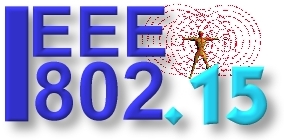
IEEE 802.15 WSN™
Task Group 4ab (TG4ab)
802.15.4 UWB Next Generation
|
|
| IEEE Wireless Zone |
| IEEE 802.18 RR TAG |
| IEEE 802.19 Coex TAG |
| IEEE 802.20 MBWA |
| IEEE 802.21 MIHS |
| IEEE 802.22 WRAN |
| IEEE 802.23 ES |
Purpose
This project is an amendment to 802.15.4-2020 and approved amendments, including 802.15.4z-2020, to further enhance the Ultra Wideband (UWB) physical layers (PHYs) and medium access control (MAC) sublayer.
This amendment builds on 802.15.4z-2020, expanding the usefulness of the standard for a wider variety of applications of UWB.
Scope
This amendment enhances the Ultra Wideband (UWB) physical layers (PHYs) medium access control (MAC), and associated ranging techniques while retaining backward compatibility with enhanced ranging capable devices (ERDEVs).
Areas of enhancement include:Support for peer-to-peer, peer-to-multi-peer, and station-to-infrastructure protocols are in scope, as are infrastructure synchronization mechanisms. This amendment includes safeguards so that the high throughput data use cases do not cause significant disruption to low duty-cycle ranging use cases.
- additional coding, preamble and modulation schemes to support improved link budget and/or reduced air-time relative to IEEE Std 802.15.4 UWB;
- additional channels and operating frequencies;
- interference mitigation techniques to support greater device density and higher traffic use cases relative to the IEEE Std 802.15.4 UWB;
- improvements to accuracy, precision, reliability and interoperability for high-integrity ranging; schemes to reduce complexity and power consumption;
- definitions for tightly coupled hybrid operation with narrowband signaling to assist UWB;
- enhanced native discovery and connection setup mechanisms;
- sensing capabilities to support presence detection and environment mapping;
- and mechanisms supporting low-power low-latency streaming as well as high data-rate streaming allowing at least 50 Mb/s of throughput.
Need
The application of Ultra Wideband (UWB) has expanded and is included in many kinds of devices including high volume consumer platforms. UWB is being applied to an ever wider range of applications using the unique capabilities of UWB to provide very accurate ranging, localization, sensing and data communication with excellent coexistence properties. New applications require added flexibility and scalability varying in size, shape and number of devices in a network from a few devices within a meter or less of each other to hundreds or more devices with distances of up to 100m. This amendment enables use of the standard in application areas previously addressed with non-standard solutions. The project addresses demands of users in the consumer, public health, industrial and transportation sectors using UWB in widely varying environments.
Information
Who to contact with questions
- Chairman: Benjamin Rolfe
- Vice Chairman: Clint Chaplin
- Vice Chairman: Clint Powell
- Vice Chairman and Recording Secretery: David Yangxun
- Technical Editor: Billy Verso
The Institute of Electrical and Electronics Engineers, Inc.